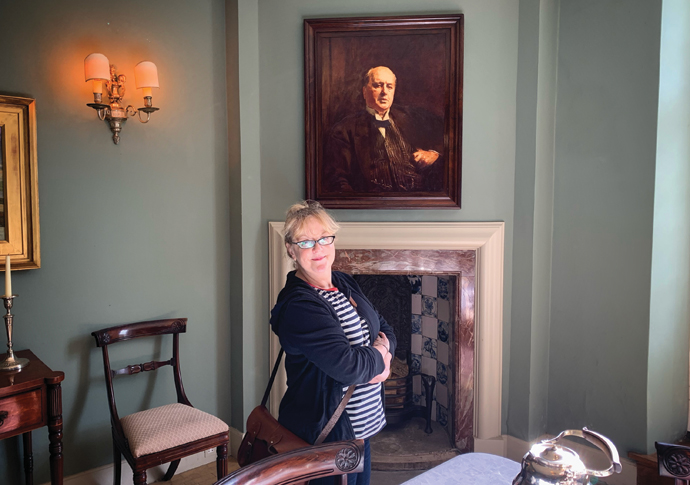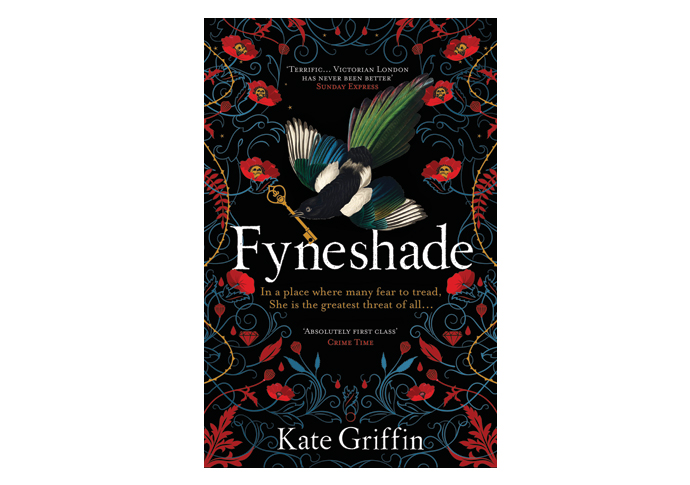A nasty turn
Barry Forshaw talks all things Gothic to Kitty Peck author Kate Griffin, whose latest book Fyneshade ‘has a few surprises up its sleeve’
Thursday, 18th May 2023 — By Barry Forshaw

Kate Griffin at Lamb House in Rye, the former home of Henry James, author of The Turn of the Screw, which inspired Fyneshade
KATE Griffin knows the past in thorough fashion – she worked as a journalist and also for Britain’s oldest heritage charity, the Society for the Protection of Ancient Buildings, a job that she clearly relished.
As a crime novelist, Kate has made a considerable mark with her lively and inventive Victorian-set mysteries, one of the glories of the current “historical noir” trend – a trend, in fact, that has several first-rate female practitioners alongside Kate: Laura Shepherd-Robinson, SJ Paris and Imogen Robertson among others.
In her debut novel, Kate’s heroine, Kitty Peck, is a bloody-minded trapeze artist – and that book, Kitty Peck and the Music Hall Murders, is a colourful and energetic dive into the milieu of the East End music halls of 1880s London, as were its impressive successors.
So, admirers of the writer might feel a certain trepidation when they hear that she is putting Kitty Peck in cold storage and tackling a stand-alone with a new heroine, the mysterious Marta, of Fyneshade.
Asked about the change of pace, Kate told Review: “The first book in my Kitty Peck series was published almost exactly a decade ago and it’s been wonderful to see the four novels in the series develop a passionate and committed following.
“But – to be frank – it was quite refreshing and alarmingly easy to ‘be’ Marta in Fyneshade. Having said that, I think that both Kitty and Marta are similar. Their stories are told from a first-person perspective and their observations on life and the worlds in which they move are untouched by sentimentality.
“I’m glad that people have found Marta acerbically funny, even though she is diabolical.”

Any worries that Kate may have made an ill-advised move are quickly set to rest within mere paragraphs of Fyneshade.
The time is the 1840s, and Marta finds out that she will have to leave her home after the death of her much-loved grandmother. Marta was obliged to give up the man she loved when her marriage was prohibited, and she takes up a position as governess at Fyneshade Hall, placed in charge of the education of the youthful daughter of Sir William Pritchard, owner of the estate.
But Marta quickly realises that she is in a maelstrom of dark secrets. Her aristocratic employer is mysteriously absent, and his son Vaughan has been banished from the house, though Marta encounters him. She finds Vaughan intriguing, and disregards the advice of the housekeeper, Mrs Gurney, that she avoid him.
The synopsis above, of course, will inevitably conjure reminiscences of Charlotte Brontë’s Jane Eyre, but this is no mere rejigging of familiar tropes – Kate, working within territory that we think we know, has a variety of provocative surprises up her sleeve.
And the Gothic sensibility that the reader may have detected in her earlier books is given full, sinister rein here. Marta is a protagonist who has had strange gifts given to her by her grandmother, and in her interactions with the duplicitous Pritchard family, she proves to be quite as doughty a fighter as Jane Eyre.
“I’m a fan of the Gothic… it’s my happy place,” Kate says. “I studied English literature at university and it was a privilege and pleasure to spend three years in the dark and stormy company of the Brontës, Mary Shelley, Bram Stoker, Edgar Allan Poe and a host of others whose tortured souls sent shivers of delight down my spine.
“Those familiar with Lady Ginger in the Kitty Peck books will recognise the debt I owe to Miss Havisham, one of the most gloriously Gothic characters in literature.”
She admits that the past is another of her “happy places.”
“I’ve been asked if I’m one of those historical writers who yearns for an earlier era. That’s probably true – I grew up on a rich TV diet of Dickens at teatime on Sunday, Doctor Who (mine was Tom Baker) travelling back into the past, Brother Cadfael’s herb of the week and Jeremy Brett’s Sherlock Holmes in that snug set of rooms in Baker Street.
“I think, for me, more than anything it’s all about the visuals. Clothes for men and women were so much more appealing in the past (subjectively, that’s anything before 1960). Although, of course, the period’s misogyny, medicine and dentistry are powerful deterrents to misty-eyed nostalgia.”
Kate’s next project takes her back a little further. She is co-authoring a historical saga focusing on the little-known 18th-century black community in the notorious St Giles Rookery.
“There was nowhere lower to fall in Georgian London, and the men, women and children who lived there were regarded as outcasts. I’m creating it – and a sequel for Simon & Schuster – with my wonderful writing partner, Marcia Hutchinson, whose parents came to England in the 1960s as part of the Windrush generation. The parallels have been jaw-dropping.”
In the meantime, the publication of her first standalone since the Kitty Peck series approaches.
Fyneshade affords the surest pleasure – not least for its clever refraction and reinvention of familiar material. Kate Griffin is known to be an admirer of Britain’s Hammer Films, and all the delights of that series – notably a full-blooded poster-coloured approach to the menacing scenario – are smoothly incorporated here.
It’s a winner.
• Fyneshade. By Kate Griffin, Viper, £16.99
• Barry Forshaw is author of Crime Fiction: A Reader’s Guide, published by Oldcastle Books